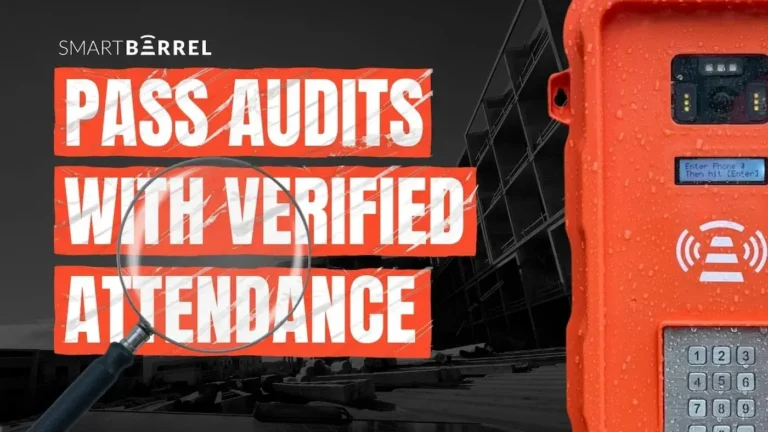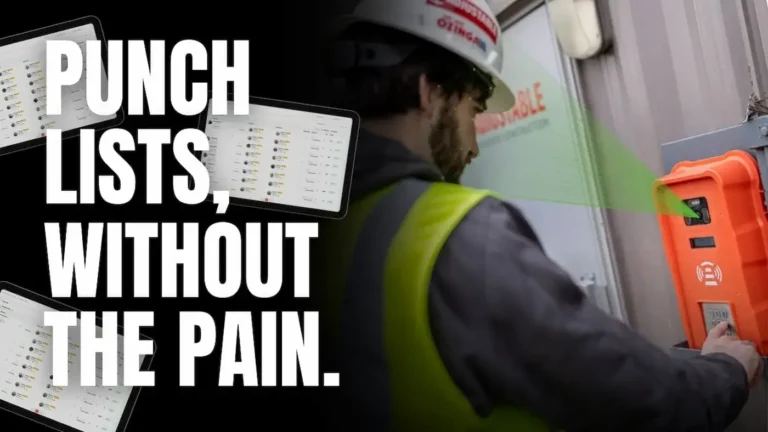T&M contracts combined with an SOW give contractors the flexibility to start fast, especially on jobs where the scope isn’t fully defined.
But that flexibility can backfire fast without tight documentation.
One missed hour, one unapproved change, and your profit disappears.
According to a study by PlanGrid and FMI:
“Poor communication and unclear scope account for $31.3 billion in rework across U.S. construction projects annually.”
That’s why pairing a detailed SOW with accurate, real-time tracking is how you keep trust, get paid, and stay in control.
In this guide, we’ll break down how T&M SOWs work and how tools like SmartBarrel keep them watertight from day one.
What Is a Statement of Work (SOW) in Construction?
A Statement of Work (SOW) is the foundation of any construction agreement. It outlines exactly what’s being built, what’s included (and what’s not), and who’s responsible for what. Zero fluff.
A strong SOW answers major questions before the job, such as:
- What’s the work being performed?
- What are the timelines and phases?
- Who supplies labor, equipment, and materials?
- How is completion defined?
When a SOW is vague or incomplete, confusion creeps in. Crews do extra work that was never scoped. Clients expect results that were never priced. And suddenly, your profit is tied up in emails, disputes, and back-and-forths.
That’s why a well-written SOW sets the baseline for accountability, especially when paired with a T&M contract. Here’s more about a T&M contract.
What Is a Time and Materials (T&M) Contract?
A Time and Materials (T&M) contract is simple on paper: the client pays for the actual time spent and the materials used.
Labor is billed hourly. Materials are billed at cost (sometimes with a markup).
T&M contracts offer flexibility when the scope is unclear or evolving.
But that same flexibility comes with risk. Without structure, T&M turns into guesswork. If you can’t show exactly how many hours were spent or what was installed, expect billing delays and scope arguments.
That’s why a solid T&M contract must clearly define:
- Billable labor categories (crews, trades, foremen)
- Hourly rates and markup
Material cost approvals - Invoice timelines and documentation standards
Get Control of Your Time Tracking
How to Use SOW and T&M in Construction Projects? 7 Pro Steps To Follow:

T&M SOWs give you flexibility, but they also demand discipline. Without clear steps, you’re stuck chasing approvals or explaining charges your client doesn’t remember agreeing to.
Here’s how to use a Time and Materials SOW the right way:
1. Define the Known Scope, But Plan for the Unknown
Start by writing a SOW that’s as complete as possible. Document every task, condition, or site constraint you know, and outline what could change.
Label what’s covered, what’s excluded, and which items are “TBD.” Use clear phrasing: “Contractor will provide framing labor and materials for new wall per plan. Electrical and plumbing scopes excluded.”
2. Set Labor Categories and Hourly Rates Upfront
You’re billing hours at specific rates tied to roles. The T&M contract must spell this out clearly.
Create a rate sheet with each billable role for foreman, journeyman, apprentice, and project manager, along with the hourly rate and any markup. Do the same for equipment (e.g., skid steer with operator, scaffold setup).
Send this rate sheet with the initial proposal or attach it as an exhibit to the contract. And don’t change rates mid-project without documented approval.
3. Break Materials into Pre-Approved vs Billable-On-Use
Your materials list needs structure.
Split it into two groups:
- Pre-approved materials (e.g., drywall, framing lumber, nails)
- Billable-on-use materials (e.g., hardware, fasteners, odd-sized fittings)
For pre-approved items, include a rough budget and quantity assumption like “Framing lumber for 300 LF of the wall at $X/unit.”
For billables, specify markup (if any), who approves them, and how receipts are submitted.
This avoids arguments about receipts and change orders later.
4. Tie Time Entries to Scope and Cost Codes Daily
Here’s where most T&M SOWs fall apart: time is logged, but not tied to anything. That’s how hours go unbilled or get disputed.
Instead, tie those daily hours by cost code or task. Each entry should show:
- Who worked
- On what task
- For how long
- Under which scope item
This turns your time entries into a map of progress and makes billing airtight.
5. Require Daily or Weekly Sign-Offs In Writing
Don’t wait until the end of the month to get your T&M hours approved. That’s where invoices go to die.
Set a standard: foremen or PMs submit T&M logs daily. The client (or their rep) reviews and signs off weekly.
With daily reports, PMs or Foreman can:
- Crew list + hours
- Work completed (brief summary)
- Materials delivered/installed
- Photos if possible
The goal isn’t to make more paperwork. The goal is to remove excuses. If the client has a chance to question something on day 3, they won’t argue it on day 30.
6. Submit Invoices on a Locked Schedule With Backup
T&M billing should follow a clock and a proper schedule.
For example, “All T&M invoices submitted by Friday EOD. Reviewed by the client on Monday. Paid by Thursday.”
Send invoices with detailed backup:
- Receipts for materials
- Subcontractor/vendor bills (if applicable)
- Any client approvals or site memos
A well-documented invoice gets paid faster. An invoice with holes triggers delays. And on a T&M job, delay equals doubt.
7. Audit Mid-Project, Not Just at Closeout
Don’t wait until closeout to review your burn. Halfway through the job, sit down with the client and walk them through labor-to-date, materials, and any overruns.
Why it works:
- You build trust by showing transparency
- You get ahead of disputes
- You catch scope issues before they spiral
It’s even better when your system gives you real-time dashboards, crew hours, task progress, and burn rates all in one place. Here’s more about it:
Get Control of Your Time Tracking
4 Ways How Smart Time Tracking Improves T&M SOW Management:

Managing a T&M SOW needs a system that verifies labor, tracks materials, documents progress, and makes billing bulletproof.
Here’s how SmartBarrel improves your T&M SOW Management with smart time tracking.
1. Accurate Time Tracking Starts on the Jobsite
In T&M projects, every labor hour has a dollar attached. If the hours aren’t logged correctly or get logged late, you’re billing blind.
SmartBarrel clocks in field crews with biometric facial verification. The system automatically logs each shift by individual, timestamp, and location, meaning no fake check-ins, and no lost hours.
2. Turn Time Entries Into Scope-Based Proof (Automatically)
Tracking time is one thing. Tying it to the right part of the job is another.
SmartBarrel lets crews assign time entries to specific cost codes or scope lines, directly from the field. Whether it’s rough framing, demo, or temporary power setup, each hour is categorized properly and tagged to the right budget bucket.
3. Real-Time Visibility Prevents Billing Delays and Scope Disputes
When PMs have to chase updates from the field, billing slows down, and so does cash flow. Worse, by the time someone questions a line item, two weeks have passed, and the paper trail is cold.
SmartBarrel fixes that by feeding real-time jobsite data into your dashboard:
- Hours worked
- Tasks completed
- Crews on-site
- Material deliveries
- Daily photos and weather
4. Smart Reports Make Invoicing Instant, Not Reactive
One of the biggest bottlenecks in T&M billing is the time it takes to build a clean invoice.
SmartBarrel generates automated daily logs that include everything you need, like:
- Verified time by worker and task
- Notes on completed work
- Photos and incident logs
- Any notes from the field
This means that when invoice day comes, the data’s already there. You’re not scrambling to build a backup but just pulling what SmartBarrel already captured.
Wrap-Up:
T&M SOWs aren’t complicated, but they require structure.
When labor, materials, and scope shift daily, the only way to stay in control is to document everything with speed and accuracy.
Done right, T&M jobs can build trust with your client, protect your margin, and move faster than fixed-price work.
Done poorly, they turn into billing delays, scope disputes, and unpaid hours.
Clarity in the contract is one part. Daily execution is the other.
If you want cleaner logs, faster approvals, and less back-and-forth on every invoice, SmartBarrel keeps your team accountable and your paperwork airtight.
See how it fits into your T&M workflow.
Get Control of Your Time Tracking
Hot Questions Answered At A Glance!
-
Who typically writes the SOW in a T&M contract?
In most cases, the contractor drafts the initial SOW and sends it to the client for approval.
The scope must be written by someone who understands the job’s actual conditions, usually the estimator, PM, or owner. The clearer the draft, the faster it gets signed.
-
Can you combine fixed-price and T&M in one contract?
Yes, and many projects do. You might price the base build at a fixed rate and handle extras or unknowns on a T&M basis. Just make sure each section is clearly labeled in the agreement and that SOWs are structured to match each billing type.
-
How should contractors handle disputed hours in a T&M agreement?
Always refer back to your documentation. Time logs should include who worked, what was done, and when.
If you’re using a system like SmartBarrel with biometric check-ins and cost-code tagging, you’ve got a solid audit trail. Disputes are harder to argue when the data is airtight.
-
What’s the biggest mistake contractors make with T&M jobs?
Lack of real-time documentation.
Waiting until the end of the week or month to log hours or receipts leads to missed billing and disputes. T&M jobs move fast, and if your tracking doesn’t move with them, money falls through the cracks.
-
Do clients ever reject a T&M model?
Yes, especially if they’ve had bad experiences in the past.
Clients want transparency and control. If you can show clear SOW language, consistent documentation, and a clean billing process,, they’re much more likely to approve a T&M structure.




